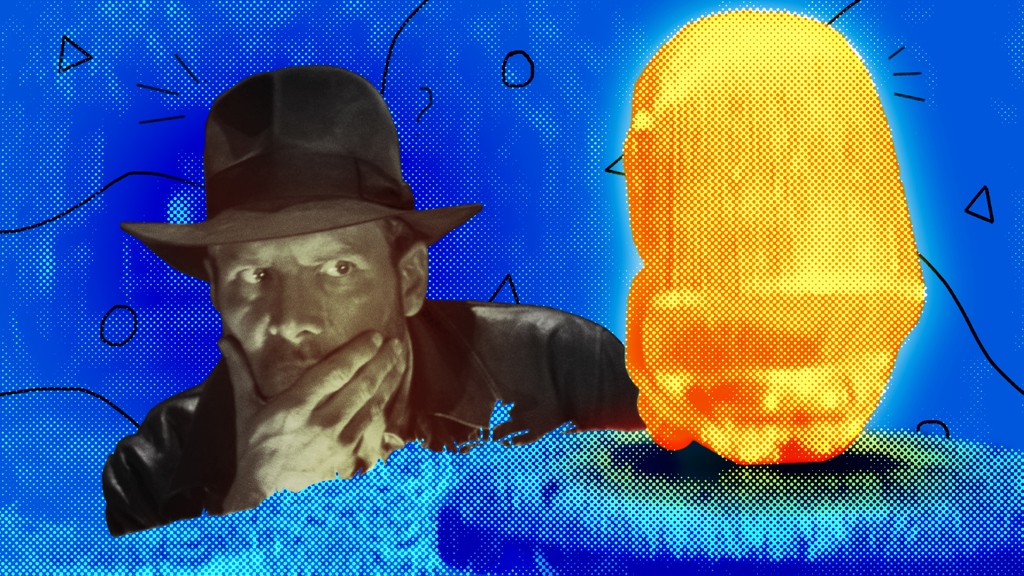Storyclock Research Log
Raiders Of The Lost Ark

This week in the Research Log, we're clocking a perfect film: RAIDER OF THE LOST ARK, written by the great and powerful Lawrence Kasdan. This was one of the first films I ever analyzed using a Storyclock. It introduced me to the idea of symmetry in storytelling, and how well-told stories with great structure and pacing have rhythm and rhyme.

I watched the movie and wrote down everything important that happened and the timecode for when it happened. Then I transferred it all to a clock, and started tracing story threads.
When I visualized the film this way, I started to notice key story beats scattered symmetrically throughout the story. This led me down the path of reverse engineering this process of story analysis into a process for story development, leading to the eventual creation of the Storyclock Notebook!
Let's Break It Down
- Opening Image: The entire opening scene serves as an "opening image," establishing the character, the world, the tone, and the potential in all of it, in a mind-boggingly efficient and effective way.
- Normalcy: After getting a taste of Indy's weekends as a globe-trotting archaeologist/universally acceptable grave robber, we get a taste of his weekdays as a dreamy professor and teacher of "FACT, not TRUTH."
- Normalcy Disrupted: Indy is approached by government men seeking information about the Ark of the Covenant.
- Herald/Refusal/etc: It doesn't take a lot to get Indy onboard for this thing. He's basically on a plane already before the government men can finish saying "ark of the covenant," but if you were to insist on running it through the monomyth machine, one could argue that the "call" Indy "refuses" is the magical/spiritual aspect of the Ark, with his "acceptance of the call" found through his devotion to history, facts, and wearing jackets in 90 degree weather.
- Acceptance: Brody stops by Indy's house that night to remind him of the film's stakes and ensure that Marion is sufficiently foreshadowed. Indy responds by laughing in his face and hurling a weapon across the room to demonstrate his understanding of both the film's stakes and the visual language of scene transition in film.
- Break Into Act 2: Indy and Dennis Muren board the plane to Nepal.
- B Story Begins: Indy travels to Nepal, where we meet Marion Ravenwood, who has the headpiece Indy needs to find the location of the Ark. We establish their complicated (and deeply problematic if you do the math) history, kicking it off with a punch to the face and an argument.
- Trailer Moments: Bar fight! Street fight! Swords! Guns! Baskets! Map room! Spiritual laser beam! Spielberg manages to craft compelling drama out of a guy placing a stick in the floor and standing there.
- Midpoint/Arrival at Solution: Indy finds the location of the Well of Souls, where the Ark is to be found. He has the locals start digging while he takes some sweet sillhouette shots for his profile (I'm sorry for this joke).
- Things Get Worse: Turns out the Well of Souls is full of snakes. Also turns out Belloch found out what they're doing. He takes the Ark and throws Marion down there with Indy and seals it up. But Indy's smart enough to know that all ancient tombs have back doors that are far easier to open than whatever complicated and trap-laden way they came in. More often than not, these back doors will open up to populated areas, and will merely require the moving of a stone to exfiltrate the premises. You may wonder why people are always going to elaborate lengths to find and infiltrate these tombs the way they do, rather than just using these back doors. It's a valid question. One I fear we may never get an answer to.
- Hero's Last Resort: Indy finds out the Ark is on a truck, chases it down, and blows it up.
- Game Over: He's got the ark. He's got Marion. They're on a ship. How is this the low point of the story? That's one of my many genius things about this movie. The low point is low not because the hero failed, it's low because the hero succeeded and yet we just don't feel like the movie is over, yet. We're not fulfilled. This can't be the end, right?
- Breakthrough and Rebirth/Break Into Act 3: Thankfully, the nazis are back (the only appropriate time to ever say that sentence). They steal Marion and the Ark. Now Indy's got something to do again. And that something is: ride a submarine across the Aegean Sea and not drown to death.
- Hero Gains Upper Hand: Indy finds himself a rocket launcher and threatens to blow up the Ark.
- Shadow's Final Push: Belloch convinces Indy not to do it, appealing to his history nerd side. Also if he did it, he'd blow Marion up, too, which wouldn't be great. Belloch and the nazis open the Ark and...
- Ultimate Breakthrough: ...surprise! God's inside, and He's not crazy about nazis. Melty face. Implosion face. Explosion face.
- New Normalcy: Indy can't get the government men to tell him where the Ark is. But he's got Marion by his side. Perhaps she was the real prize all along.
- Final Image: The Ark is wheeled into a massive warehouse, never to be seen again. Until it's seen again.
- Symmetrical Beats: The Ark is first mentioned and we see a picture of it being opened + Indy finds the location of the Ark + Indy finds the ark + the Ark is opened.
- Symmetrical Beats: Marion punches Indy + Marion kisses Indy.
- Symmetrical Beats: Belloch takes the idol + Belloch takes Marion + Belloch takes the Ark + the Ark takes Belloch.
Stuff That Stood Out To Me
- It's fascinating that this movie is so perfect when you consider that the film was actually an experiment in imperfection for Spielberg. Having become known in Hollywood as a perfectionist who often came in over budget and behind schedule, he and George Lucas agreed to shoot the film as efficiently as possible, even if it meant settling for less-than-perfect takes. I preach all the time that perfection is a myth and a hinderance for filmmakers, and that your success is often determined by how you choose to settle.
- The opening is like a proof of concept short for the rest of the film. It's so good that, supposedly, Spielberg was worried that he'd made the opening too good, and that the rest of the film would never live up to it.
- Marion appears to stone cold die before we even reach the midpoint. An insanely bold move to make in a fun adventure movie like this, but an even more insanely bold move to make so soon after you've introduced the character!
- The nazis are brought up in conversation quite a lot, but we don't actually see a nazi uniform for most of the first half of the film. The first time we see a swastika is on the flag in the map room. Another lessons in how keeping your villainous force in the shadows as long as possible will make their eventual arrival more impactful.
How cool is it that on one side of the clock we have Indy showing us a history book illustration of the Ark being opened, and directly opposite that we have the Ark actually being opened?
But here's the thing, and this is important: none of this means that Lawrence Kasdan wrote RAIDERS OF THE LOST ARK with a storyclock.
What it does mean: well-told stories have rhythm and rhyme. Great structure and pacing are what create this kind of symmetry.
It also means we can reverse engineer this whole crazy concept of story symmetry to help us in developing our own story ideas. If you want to learn more, check out my post about my short film, OLD/NEW, as well as any of our Storyclock video tutorials.
If you liked this post, check out our other Storyclock Research Logs, where we break down the structure of our favorite films, tv shows, video games, and more!





